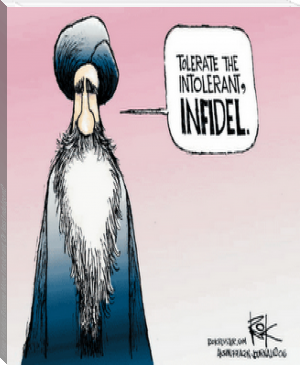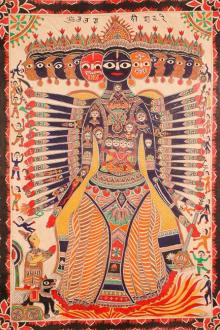Puppets of Faith: Theory of Communal Strife (A Critical Appraisal of Islamic faith, Indian polity), BS Murthy [microsoft ebook reader .TXT] 📗

- Author: BS Murthy
Book online «Puppets of Faith: Theory of Communal Strife (A Critical Appraisal of Islamic faith, Indian polity), BS Murthy [microsoft ebook reader .TXT] 📗». Author BS Murthy
It has often been suggested, unfairly though, that Hindus have no sense of history and thus failed to record their journey down the historical lane. However, what is not appreciated is that the grand libraries in Takshasila ‘n Nalanda Universities, among their premier seats of learning of yore, which could have held the records of their history from the ancient times, were vandalized by the bigoted Musalmans. That Nalanda itself is believed to have housed over nine million books and other literary works, which sustained its arson by Bakhtiyar Khilji’s for three months in 1,193 C.E., should give one an idea of the magnitude of the Hindu ‘historical’ loss.
Thus, bereft of their ancient history and having been fed thereafter with the unpalatable diet prepared for them by Musalmans and the Christians, who together ruled them for a millennium, Hindus have no clue about their past moorings. So, needless to say, the ‘in vogue’ Indian history is the victors’ version of it about the vanquished that the Hindu left-liberals and the Islamic supremacists lend credence to, and what is worse; the Hindus are made to believe they were not even their native selves but the hybrids of Aryans who migrated to India from Eurasia in 1,500 B.C.E.
The moot point is whether the Aryans descended upon Ila Varta aka Bharat Varsha with all four Vedas in their kitty to rechristen it as Arya Varta. Had it been the case, then it is reasonable to assume that there would have been claimants for the Vedic legacy in Eurasia as well, but as it is not the case, it can be said without any contradiction that the theory of the Aryan migration is devoid of any base. Moreover, now the growing school of thought, supported by DNA analysis that India’s populace is both indigenous as well as homogenous should debunk this theory invented by the Whites, probably to appropriate the ‘admired’ Hindu philosophical legacy to their race or as a ploy to divide the Hindus, they came to colonize, on racial lines for political ends and / or both. Even if Aryans did indeed migrate to India that would have been in their nomadic state and it was India’s evolved environs that would have enabled them to acquire their intellectual sophistication that they displayed in the Vedas, Brahmasutras, and Upanishads in later years. And for the doubters, once out of slavery, haven’t the Jews, in due course, transformed themselves into an intellectually formidable race on earth.
Be that as it may, for the final nail in the coffin of the doubtful theory is yet to be hammered home, we may still go along with it for the sake of analyzing the evolution of the Hindu social order, which may hold well even in the non-Aryan setting. So, an enquiry into the origins and the evolution of sanātana dharma in Bharat Varsha is warranted, however bearing in mind the discovery, of the presence of the Indus Valley Civilization at Mohen jo daro in Sind and Harappa in Punjab way back in 3,500 B.C.E, which is bound to address the question of the Aryan philosophical purity as well.
By the time of the said Aryan arrival, or the more probable emergence of a fair-skinned Indian tribe bearing the same name, or a similar sounding one (Native namesake), as the dominant force, even if the glorious ancient civilization were to be extinct by then, yet the remnants of its culture should have been still extant. After all, a civilization is but the cultural ethos of a people, and culture itself is a synthesis of the communal arrangement in a given society. Hence, it can be assumed that a stable polity would have been in existence in the ancient Bharat Varsha, probably dating back to 7,500 B.C.E. that is going by the recent discovery of a submerged city in the Gulf of Khambhat, off the coast of Gujarat.
That being the case, the usage of ‘Aryan’ in this study should be taken as the generic term referring the people, be it aliens or natives, who came to shape the Hindu social and religious order.
But, the Aryan cultural hegemony, over the life and times of all others, that anyway is to be expected, left no traces of the old social order for us to divine that is owing to the destruction of its archives by Muslim marauders and others. Thus, for all practical purposes, the prevalent communal code with caste as creed, apparently in vogue from the Vedic times, is the only known social mores of India’s ancient past.
Though we might remain clueless about the ancient Indian social arrangement, yet, we may speculate about its probable influence on the evolution of the new way of life, under the aegis of the Aryans, which eventually became the Hindu way of life known as sanātana dharma in the times of yore and Hindutva in the current age. Just the same, as they were set to dominate the polity of the land that came into their hand, they could be expected to have been acquainted with the nuances of the cultural ethos of other native tribes.
Hence, it would be interesting to speculate as to how the Aryans should’ve subdued the native majority, without a fight, only to absorb their culture in the polity they evolved. It seems probable, notwithstanding their mental prowess exemplified by the civilization of Mohen jo daro and Harappa; those people might not have been martial races. Added to that, they should have been either depressed economically or depleted in numbers or even disjointed politically, could be owing to famines, floods or fights among themselves occasioned by petty jealousies of the communes. Whatever, they obviously were unable or unwilling to offer any significant resistance to the incoming Aryans or their Native namesakes, as the case may be; also, the latter’s adventurous spirit should have overawed them into surrendering to that emergent force. In support of this presumption, in all of Vedic literature, we have no account of any battle royal fought by them with the other inhabitants. Well, the battle of Mahābhārata was fought some 1,500 years before these newbies are said to have arrived on the scene in the ancient land. Besides, won’t the latter-day Indian history – of Islamic invasions and British colonization - vouch for this native characteristic?
Whatever it was, the new lords became the overlords of all they purveyed in the land they took pride in as Arya Varta, which they came to believe as their karma bhōmi. It goes without saying that these newbies would have needed a social structure in place to dominate the others they subdued. It was thus, the colour of the skin could have played its part in stratifying the society, and it is not without significance that as they would have been fair-skinned, they made the concept of caste as varna, which in Sanskrit means colour. The subdued people, probably a mix of brown and black, could not have measured up to their fair skin, and thus in the psychological sense, were unequal to them to start with. Why wouldn’t the Whitemen’s psychological dominance of the physically far more endowed African blacks in modern times, so much so that they could enslave them, support this proposition? Just the same, on account of the real politick; the newbies could not have afforded to keep the others out of their socio-cultural orbit, and yet, it was imperative for them to preclude any politico-cultural threat from them as well. It was to serve these ends that they might have looked for ways and means for keeping the others in an extended social fold, albeit at arm’s length. And the result of this newbie’s political compulsion could have been behind the evolution of the caste system, so unique to the human experience.
Needless to say, an organized culture, as the one available to the native tribes, would have had some class structure of its own. The imperative for the newbies would have been to devise a new social order, without disturbing the old, in a way to accommodate all the others at the lower ends; needless to say, placing themselves at the acme of the new social pyramid they built. Thus, the native brown-skinned would have been ‘casted away’ as vaisyas and sudras in that order, depending upon their social status or occupation, and / or both. It’s thus; the caste system so devised by them to integrate themselves into the polity, while dividing the others from one another, was brilliant though cynical. With the newbies’ social comfort zone thus drawn, the unfortunate blacks amongst the natives were dubbed as antyaja only to be eventually relegated as untouchables.
To enforce their caste law as law of the land, the newbies would have earmarked muscle-men amongst them as bouncers, who in time came to be christened as kshatriyas. At some length, however, their intellectual class might have wanted to institutionalize their social supremacy for all times to come, and it was towards this end that they posited themselves as Brahmans at the apex of the caste structure, which they helped build over the ruins of the then prevailing social orders. And in order to perpetuate the caste hierarchy thus evolved, the Brahmans envisioned the concept of swadharma, which, being caste specific, not only defined the caste ethos but also drew the caste boundaries. It was thus, Brahmans, as a caste, came to be the shepherds of the Hindu philosophy and culture for centuries to come.
So, it were these very Brahmans who gifted Sanskrit to the world, whose incredible beauty makes the Hindus believe that it is the deva bhasha, the language of the gods. Hence, it’s no wonder that the British Indologist, Sir William Jones, a Greek and Latin scholar, who mastered it as well, should have remarked that, ‘Sanskrit is of wonderful structure, more perfect than Greek, more copious than Latin, and more exquisitely refined than either’.
Nowhere in the annals of human history that a small group of people, by the privilege of birth or the faculties of mind, and / or both, came to monopolize the soul of a people, the spirit of a culture and the destiny of a society for so long as the Brahmans in Bharat did. Only a unique sense of their destiny, or the arrogance of their perceived superiority, should’ve enabled the Brahmans to eventually posit themselves as angels on earth, endowed with, lo the power to control the gods themselves, well, with the mantras, composed by them in the language of the gods at that. And that is what Nārāyana Upanishad expostulates as follows:
daiva dēnam jagat sarvam, / mantrā dēnantu daivatam,
tan mantram brāhmanādēnam, / brāhmano mama dēvata.
It’s on god that hinges all / Mantras rein in that godhood
Controlled are those by Brahmans / Making them our own angels.
In the end, it was this Brahmanical arrogance that brought about the degeneration of the expansive sanātana dharma, evolved by their forebears, into the narrow Brahmanism, exemplified by swadharma, to the eternal hurt of Hinduism. However, to be fair to them, it’s not that they committed any fraud on the gullible public on that score, for they truly believed that the gods could indeed be appeased with their mantras. Besides, they felt it was their destiny to intercede between gods and man for the well-being of the latter, and thus strived to equip themselves to fulfill the





Comments (0)